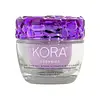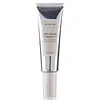What's inside
What's inside
 Key Ingredients
Key Ingredients

 Benefits
Benefits

 Concerns
Concerns

 Ingredients Side-by-side
Ingredients Side-by-side

Aloe Barbadensis Leaf Juice
Skin ConditioningGlycerin
HumectantCetearyl Alcohol
EmollientCoconut Alkanes
EmollientWater
Skin ConditioningHelianthus Annuus Flower
Skin ConditioningLactobacillus Ferment
Skin ConditioningSorbitan Olivate
EmulsifyingCetearyl Olivate
Butyrospermum Parkii Butter
Skin ConditioningEuterpe Oleracea Fruit Extract
Bakuchiol
AntimicrobialRosa Canina Fruit Oil
EmollientLactobacillus
Skin ConditioningCeramide NP
Skin ConditioningCoco-Caprylate/Caprate
EmollientEragrostis Tef Seed Extract
EmollientSclerotium Gum
Emulsion StabilisingCocos Nucifera Fruit Extract
EmollientPotassium Sorbate
PreservativeMedicago Sativa Extract
TonicEclipta Prostrata Extract
Skin ConditioningCitric Acid
BufferingMelia Azadirachta Leaf Extract
Skin ConditioningPelargonium Graveolens Flower Oil
MaskingSodium Phytate
Citrus Aurantium Amara Flower Oil
MaskingMelia Azadirachta Flower Extract
Skin ConditioningCorallina Officinalis Extract
Skin ConditioningSodium Benzoate
MaskingMorinda Citrifolia Fruit Extract
Skin ConditioningCoccinia Indica Fruit Extract
Skin ConditioningTocopherol
AntioxidantMoringa Oleifera Seed Oil
EmollientSolanum Melongena Fruit Extract
Skin ConditioningAloe Barbadensis Flower Extract
EmollientSimmondsia Chinensis Seed Oil
EmollientCurcuma Longa Root Extract
MaskingOcimum Basilicum Flower/Leaf Extract
TonicOcimum Sanctum Leaf Extract
Skin ConditioningAlcohol
AntimicrobialLinalool
PerfumingCitronellol
PerfumingGeraniol
PerfumingLimonene
PerfumingFarnesol
PerfumingAloe Barbadensis Leaf Juice, Glycerin, Cetearyl Alcohol, Coconut Alkanes, Water, Helianthus Annuus Flower, Lactobacillus Ferment, Sorbitan Olivate, Cetearyl Olivate, Butyrospermum Parkii Butter, Euterpe Oleracea Fruit Extract, Bakuchiol, Rosa Canina Fruit Oil, Lactobacillus, Ceramide NP, Coco-Caprylate/Caprate, Eragrostis Tef Seed Extract, Sclerotium Gum, Cocos Nucifera Fruit Extract, Potassium Sorbate, Medicago Sativa Extract, Eclipta Prostrata Extract, Citric Acid, Melia Azadirachta Leaf Extract, Pelargonium Graveolens Flower Oil, Sodium Phytate, Citrus Aurantium Amara Flower Oil, Melia Azadirachta Flower Extract, Corallina Officinalis Extract, Sodium Benzoate, Morinda Citrifolia Fruit Extract, Coccinia Indica Fruit Extract, Tocopherol, Moringa Oleifera Seed Oil, Solanum Melongena Fruit Extract, Aloe Barbadensis Flower Extract, Simmondsia Chinensis Seed Oil, Curcuma Longa Root Extract, Ocimum Basilicum Flower/Leaf Extract, Ocimum Sanctum Leaf Extract, Alcohol, Linalool, Citronellol, Geraniol, Limonene, Farnesol
Water
Skin ConditioningGlycerin
HumectantDimethicone
EmollientSimmondsia Chinensis Seed Oil
EmollientSqualane
EmollientGlyceryl Stearate
EmollientCetyl Alcohol
EmollientNiacinamide
SmoothingStearyl Alcohol
EmollientPalmitoyl Tripeptide-5
Skin ConditioningPantolactone
HumectantPalmitoyl Tripeptide-1
Skin ConditioningPalmitoyl Tetrapeptide-7
Skin ConditioningHydrolyzed Plukenetia Volubilis Seed Extract
Emulsion StabilisingDunaliella Salina Extract
Skin ConditioningSodium Hyaluronate
Humectant3-O-Ethyl Ascorbic Acid
Skin ConditioningPanthenol
Skin ConditioningCaryodendron Orinocense Seed Oil
EmollientHonokiol
AntioxidantMagnolol
AntioxidantPalmitic Acid
EmollientSorbitan Oleate
EmulsifyingAluminum Starch Octenylsuccinate
AbsorbentHydroxyacetophenone
AntioxidantStearic Acid
CleansingAcrylamide/Sodium Acryloyldimethyltaurate Copolymer
Emulsion StabilisingPolyglyceryl-6 Laurate
Emulsifying1,2-Hexanediol
Skin ConditioningBoron Nitride
AbsorbentCaprylyl Glycol
EmollientPolyglyceryl-10 Oleate
Skin ConditioningIsohexadecane
EmollientButylene Glycol
HumectantChlorphenesin
AntimicrobialAcrylates/C10-30 Alkyl Acrylate Crosspolymer
Emulsion StabilisingTocopheryl Acetate
AntioxidantPolysorbate 80
EmulsifyingSorbitan Palmitate
EmulsifyingSodium Hydroxide
BufferingSodium Benzoate
MaskingCarbomer
Emulsion StabilisingSodium Lactate
BufferingPhenoxyethanol
PreservativePolysorbate 20
EmulsifyingCitric Acid
BufferingEthylhexylglycerin
Skin ConditioningPotassium Sorbate
PreservativeWater, Glycerin, Dimethicone, Simmondsia Chinensis Seed Oil, Squalane, Glyceryl Stearate, Cetyl Alcohol, Niacinamide, Stearyl Alcohol, Palmitoyl Tripeptide-5, Pantolactone, Palmitoyl Tripeptide-1, Palmitoyl Tetrapeptide-7, Hydrolyzed Plukenetia Volubilis Seed Extract, Dunaliella Salina Extract, Sodium Hyaluronate, 3-O-Ethyl Ascorbic Acid, Panthenol, Caryodendron Orinocense Seed Oil, Honokiol, Magnolol, Palmitic Acid, Sorbitan Oleate, Aluminum Starch Octenylsuccinate, Hydroxyacetophenone, Stearic Acid, Acrylamide/Sodium Acryloyldimethyltaurate Copolymer, Polyglyceryl-6 Laurate, 1,2-Hexanediol, Boron Nitride, Caprylyl Glycol, Polyglyceryl-10 Oleate, Isohexadecane, Butylene Glycol, Chlorphenesin, Acrylates/C10-30 Alkyl Acrylate Crosspolymer, Tocopheryl Acetate, Polysorbate 80, Sorbitan Palmitate, Sodium Hydroxide, Sodium Benzoate, Carbomer, Sodium Lactate, Phenoxyethanol, Polysorbate 20, Citric Acid, Ethylhexylglycerin, Potassium Sorbate
 Reviews
Reviews

Ingredients Explained
These ingredients are found in both products.
Ingredients higher up in an ingredient list are typically present in a larger amount.
Citric Acid is an alpha hydroxy acid (AHA) naturally found in citrus fruits like oranges, lemons, and limes.
Like other AHAs, citric acid can exfoliate skin by breaking down the bonds that hold dead skin cells together. This helps reveal smoother and brighter skin underneath.
However, this exfoliating effect only happens at high concentrations (20%) which can be hard to find in cosmetic products.
Due to this, citric acid is usually included in small amounts as a pH adjuster. This helps keep products slightly more acidic and compatible with skin's natural pH.
In skincare formulas, citric acid can:
While it can provide some skin benefits, research shows lactic acid and glycolic acid are generally more effective and less irritating exfoliants.
Most citric acid used in skincare today is made by fermenting sugars (usually from molasses). This synthetic version is identical to the natural citrus form but easier to stabilize and use in formulations.
Read more about some other popular AHA's here:
Learn more about Citric AcidGlycerin is already naturally found in your skin. It helps moisturize and protect your skin.
A study from 2016 found glycerin to be more effective as a humectant than AHAs and hyaluronic acid.
As a humectant, it helps the skin stay hydrated by pulling moisture to your skin. The low molecular weight of glycerin allows it to pull moisture into the deeper layers of your skin.
Hydrated skin improves your skin barrier; Your skin barrier helps protect against irritants and bacteria.
Glycerin has also been found to have antimicrobial and antiviral properties. Due to these properties, glycerin is often used in wound and burn treatments.
In cosmetics, glycerin is usually derived from plants such as soybean or palm. However, it can also be sourced from animals, such as tallow or animal fat.
This ingredient is organic, colorless, odorless, and non-toxic.
Glycerin is the name for this ingredient in American English. British English uses Glycerol/Glycerine.
Learn more about GlycerinPotassium Sorbate is a preservative used to prevent yeast and mold in products. It is commonly found in both cosmetic and food products.
This ingredient comes from potassium salt derived from sorbic acid. Sorbic acid is a natural antibiotic and effective against fungus.
Both potassium sorbate and sorbic acid can be found in baked goods, cheeses, dried meats, dried fruit, ice cream, pickles, wine, yogurt, and more.
You'll often find this ingredient used with other preservatives.
Learn more about Potassium SorbateThis oil comes from the seeds of the desert shrub called Jojoba. It is more commonly known as jojoba oil, a non-comedogenic oil.
Jojoba oil does not contain fragrance and has many fatty-acids, making it a great soothing ingredient.
It also contains Vitamin E, a great moisturizing ingredient. Vitamin E is also an antioxidant and protects your skin against oxidative damage.
This ingredient humectant properties, meaning it helps draw moisture from the air. This helps keep your skin hydrated.
While jojoba has antibacterial properties, it is only able to kill some strains of bacteria.
Studies also show it helps in wound healing. In fact, Indigenous cultures have used jojoba as a moisturizer and to help treat burns for centuries.
Fun fact: Jojoba oil similar to natural human skin sebum, so it has a great effect on dry skin. It is also promising with helping to regulate sebum production.
Due to its fatty acid content, Jojoba oil may not be fungal acne safe. We recommend speaking with a professional if you have any concerns.
Learn more about Simmondsia Chinensis Seed OilSodium Benzoate is a preservative. It's used in both cosmetic and food products to inhibit the growth of mold and bacteria. It is typically produced synthetically.
Both the US FDA and EU Health Committee have approved the use of sodium benzoate. In the US, levels of 0.1% (of the total product) are allowed.
Sodium benzoate works as a preservative by inhibiting the growth of bacteria inside of cells. It prevents the cell from fermenting a type of sugar using an enzyme called phosphofructokinase.
It is the salt of benzoic acid. Foods containing sodium benzoate include soda, salad dressings, condiments, fruit juices, wines, and snack foods.
Studies for using ascorbic acid and sodium benzoate in cosmetics are lacking, especially in skincare routines with multiple steps.
We always recommend speaking with a professional, such as a dermatologist, if you have any concerns.
Learn more about Sodium BenzoateWater. It's the most common cosmetic ingredient of all. You'll usually see it at the top of ingredient lists, meaning that it makes up the largest part of the product.
So why is it so popular? Water most often acts as a solvent - this means that it helps dissolve other ingredients into the formulation.
You'll also recognize water as that liquid we all need to stay alive. If you see this, drink a glass of water. Stay hydrated!
Learn more about Water